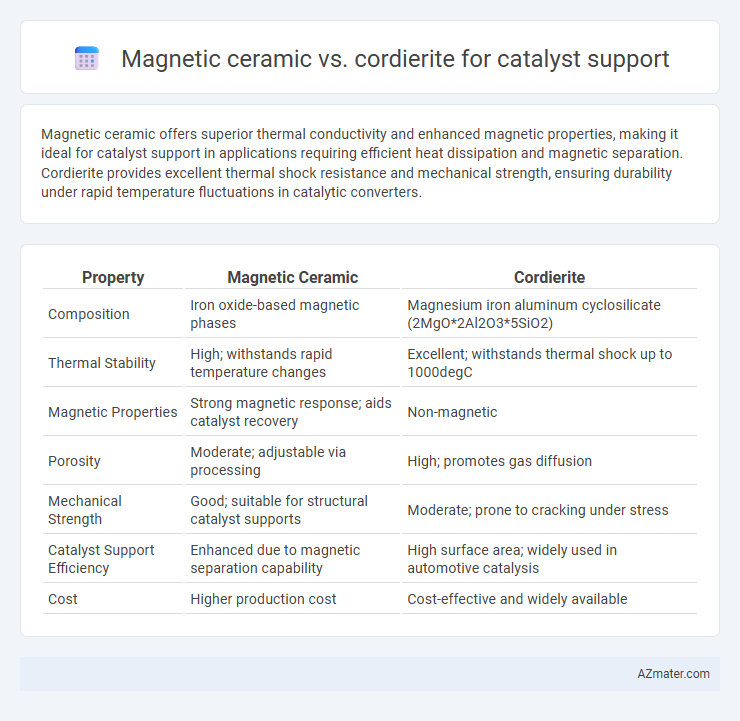Magnetic ceramic offers superior thermal conductivity and enhanced magnetic properties, making it ideal for catalyst support in applications requiring efficient heat dissipation and magnetic separation. Cordierite provides excellent thermal shock resistance and mechanical strength, ensuring durability under rapid temperature fluctuations in catalytic converters.
Table of Comparison
| Property | Magnetic Ceramic | Cordierite |
|---|---|---|
| Composition | Iron oxide-based magnetic phases | Magnesium iron aluminum cyclosilicate (2MgO*2Al2O3*5SiO2) |
| Thermal Stability | High; withstands rapid temperature changes | Excellent; withstands thermal shock up to 1000degC |
| Magnetic Properties | Strong magnetic response; aids catalyst recovery | Non-magnetic |
| Porosity | Moderate; adjustable via processing | High; promotes gas diffusion |
| Mechanical Strength | Good; suitable for structural catalyst supports | Moderate; prone to cracking under stress |
| Catalyst Support Efficiency | Enhanced due to magnetic separation capability | High surface area; widely used in automotive catalysis |
| Cost | Higher production cost | Cost-effective and widely available |
Overview of Catalyst Support Materials
Magnetic ceramic and cordierite are prominent materials used as catalyst supports due to their thermal stability and mechanical strength. Magnetic ceramics offer excellent magnetic properties and high thermal shock resistance, making them suitable for catalytic converters in harsh environments. Cordierite, known for its low thermal expansion and high resistance to thermal deformation, remains a preferred choice for automotive and industrial catalyst substrates.
Introduction to Magnetic Ceramics
Magnetic ceramics are advanced materials characterized by their ferromagnetic or ferrimagnetic properties, making them ideal for catalyst supports due to enhanced magnetic separation capabilities. These ceramics typically exhibit high thermal stability, chemical inertness, and mechanical strength, outperforming traditional cordierite supports in durability and recyclability. Magnetic ceramic catalyst supports enable efficient catalyst recovery and reuse through magnetic fields, reducing environmental impact and operational costs in industrial processes.
Understanding Cordierite as a Catalyst Support
Cordierite is a widely used catalyst support material due to its excellent thermal stability, low thermal expansion coefficient, and high resistance to thermal shock, making it ideal for high-temperature catalytic converter applications. Its porous structure enables efficient gas flow and effective dispersion of catalytic active sites, enhancing overall catalyst performance. Compared to magnetic ceramics, cordierite offers superior mechanical strength and durability under harsh operating conditions, which contributes to longer catalyst lifespan and improved emission control.
Comparative Structural Properties
Magnetic ceramics exhibit higher magnetic permeability and enhanced thermal stability compared to cordierite, making them advantageous for catalyst support under high-temperature conditions. Cordierite possesses a lower thermal expansion coefficient and superior mechanical strength, offering dimensional stability and resistance to thermal shock. The porous structure of magnetic ceramics facilitates improved catalytic activity through increased surface area, while cordierite's dense microstructure ensures durability and long-term performance.
Thermal Stability: Magnetic Ceramics vs. Cordierite
Magnetic ceramics exhibit superior thermal stability compared to cordierite, maintaining structural integrity and performance at temperatures exceeding 1200degC, while cordierite typically withstands up to 1000degC before deformation. The high Curie temperature and low thermal expansion coefficient of magnetic ceramics reduce thermal shock risks, enhancing catalyst longevity in automotive and industrial applications. Cordierite's relative thermal fragility often results in cracking and diminished catalyst support efficiency under rapid temperature fluctuations.
Porosity and Surface Area Analysis
Magnetic ceramic catalyst supports typically exhibit higher porosity levels compared to cordierite, facilitating enhanced mass transport and improved catalytic activity. Surface area analysis reveals that magnetic ceramics offer greater specific surface areas, promoting more active sites for catalyst dispersion. Cordierite, with its lower porosity and surface area, provides superior mechanical strength but may limit catalytic efficiency due to reduced active surface availability.
Chemical Compatibility and Resistance
Magnetic ceramic materials exhibit excellent chemical compatibility and high resistance to acidic and oxidative environments, making them ideal for catalyst support applications requiring durability under harsh conditions. Cordierite offers superior thermal shock resistance and chemical inertness, particularly against alkalis and acids, ensuring stability and longevity in catalyst systems exposed to fluctuating temperatures and aggressive chemicals. Comparative studies highlight magnetic ceramics' enhanced resistance to corrosive agents, while cordierite remains favored for applications demanding dimensional stability and low thermal expansion.
Catalyst Loading and Distribution Efficiency
Magnetic ceramic catalyst supports exhibit superior catalyst loading capacity due to their high surface area and porosity compared to cordierite supports, resulting in enhanced active site availability. Cordierite offers excellent thermal stability but lower catalyst dispersion efficiency, limiting uniform distribution and catalytic performance. Optimizing magnetic ceramic supports maximizes catalyst utilization and improves overall conversion rates in catalytic processes.
Industrial Applications and Case Studies
Magnetic ceramics provide superior thermal stability and enhanced magnetic separation capabilities, making them ideal for catalyst supports in industrial applications such as petrochemical refining and wastewater treatment. Cordierite, known for its excellent thermal shock resistance and low thermal expansion, is widely used in automotive catalytic converters and industrial gas purification systems. Case studies demonstrate that magnetic ceramic catalyst supports improve catalyst recovery and lifespan in high-temperature reactors, while cordierite excels in environments requiring rapid temperature fluctuations and mechanical durability.
Cost-effectiveness and Future Prospects
Magnetic ceramic catalyst supports offer enhanced thermal conductivity and durability compared to cordierite, translating to longer service life and reduced replacement costs. Cordierite remains widely favored due to its low manufacturing cost and proven performance in high-temperature stability, balancing initial investment and operational efficiency. Emerging advancements in magnetic ceramic synthesis and scalability suggest promising future prospects for cost competitiveness and improved catalytic efficiency in automotive and industrial applications.

Infographic: Magnetic ceramic vs Cordierite for Catalyst support
 azmater.com
azmater.com